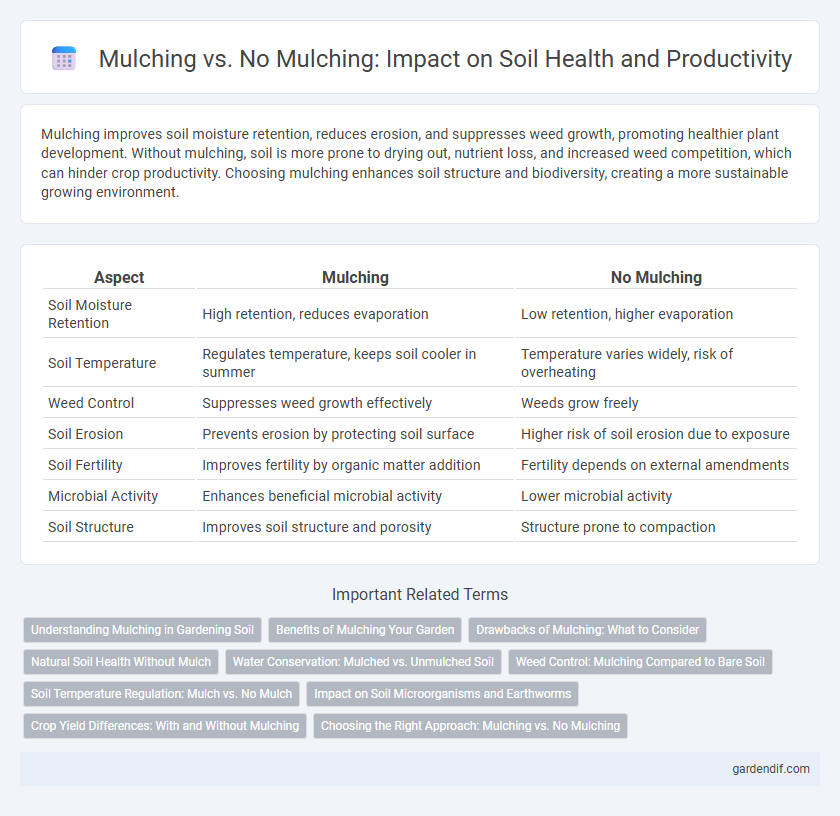
Mulching vs No mulching Illustration
Mulching improves soil moisture retention, reduces erosion, and suppresses weed growth, promoting healthier plant development. Without mulching, soil is more prone to drying out, nutrient loss, and increased weed competition, which can hinder crop productivity. Choosing mulching enhances soil structure and biodiversity, creating a more sustainable growing environment.
Table of Comparison
| Aspect | Mulching | No Mulching |
|---|---|---|
| Soil Moisture Retention | High retention, reduces evaporation | Low retention, higher evaporation |
| Soil Temperature | Regulates temperature, keeps soil cooler in summer | Temperature varies widely, risk of overheating |
| Weed Control | Suppresses weed growth effectively | Weeds grow freely |
| Soil Erosion | Prevents erosion by protecting soil surface | Higher risk of soil erosion due to exposure |
| Soil Fertility | Improves fertility by organic matter addition | Fertility depends on external amendments |
| Microbial Activity | Enhances beneficial microbial activity | Lower microbial activity |
| Soil Structure | Improves soil structure and porosity | Structure prone to compaction |
Understanding Mulching in Gardening Soil
Mulching improves soil moisture retention by reducing evaporation and helps regulate soil temperature for plant root health. Organic mulch materials, such as wood chips or straw, decompose over time, enriching soil with essential nutrients and promoting beneficial microbial activity. Without mulching, soil is more prone to erosion, nutrient loss, and temperature fluctuations, which can hinder plant growth and soil structure.
Benefits of Mulching Your Garden
Mulching your garden significantly improves soil moisture retention, reducing the need for frequent watering and promoting healthier plants. It also suppresses weed growth, minimizing competition for nutrients and sunlight, which enhances overall garden productivity. Furthermore, mulching helps regulate soil temperature and adds organic matter as it decomposes, enriching soil fertility and structure.
Drawbacks of Mulching: What to Consider
Mulching can lead to excessive moisture retention, which fosters fungal growth and root rot in certain soil types. It may also create a habitat for pests such as rodents and insects, potentially harming plants. Poor-quality mulch or improper application can result in nutrient imbalances by tying up nitrogen during decomposition.
Natural Soil Health Without Mulch
Natural soil health without mulch relies heavily on maintaining organic matter through crop residues and cover crops, which support microbial activity and nutrient cycling. While mulching can reduce erosion and moisture loss, soils without mulch often foster deeper root systems and increased soil aeration, promoting robust microbial diversity. However, such soils require careful management to prevent compaction and moisture stress during dry periods.
Water Conservation: Mulched vs. Unmulched Soil
Mulched soil retains moisture more effectively, reducing evaporation rates by up to 50% compared to unmulched soil, which enhances water conservation in agricultural and garden settings. The organic layer in mulching acts as a barrier, maintaining consistent soil temperature and humidity, which supports plant health during dry periods. In contrast, unmulched soil often experiences rapid moisture loss, leading to increased irrigation needs and less efficient water use.
Weed Control: Mulching Compared to Bare Soil
Mulching significantly improves weed control by creating a physical barrier that suppresses weed seed germination and growth, resulting in reduced competition for nutrients and water. In contrast, bare soil provides an ideal environment for weed seeds to sprout and establish, leading to increased weed density and maintenance efforts. Studies indicate that organic mulches can reduce weed biomass by up to 90%, enhancing crop productivity and soil health.
Soil Temperature Regulation: Mulch vs. No Mulch
Mulching significantly moderates soil temperature by providing insulation that keeps the soil cooler in summer and warmer in winter compared to bare soil. Without mulch, soil experiences greater temperature fluctuations that can stress plant roots and reduce microbial activity. This temperature regulation through mulching supports healthier soil ecosystems and enhances plant growth stability.
Impact on Soil Microorganisms and Earthworms
Mulching significantly enhances soil microbial diversity and activity by maintaining moisture levels and providing organic matter as a food source, which in turn fosters a healthier ecosystem. In contrast, no mulching often leads to reduced microbial populations and diminished earthworm activity due to soil exposure, temperature fluctuations, and moisture loss. Earthworms thrive in mulched soils because the organic material improves soil structure and nutrient availability, directly benefiting soil fertility and plant growth.
Crop Yield Differences: With and Without Mulching
Mulching significantly enhances crop yields by conserving soil moisture, regulating temperature, and suppressing weed growth, leading to healthier plant development and higher productivity. Studies show that mulched fields can increase crop yields by 20-50% compared to no mulching, depending on crop type and environmental conditions. Without mulching, soil moisture evaporates faster, and temperature fluctuations stress plants, reducing overall yield potential.
Choosing the Right Approach: Mulching vs. No Mulching
Mulching enhances soil moisture retention, temperature regulation, and weed suppression, promoting healthier plant growth compared to no mulching. Selecting the right approach depends on soil type, climate conditions, and crop requirements, where mulching benefits sandy or loose soils prone to erosion and drought. No mulching may be preferable in wet climates or for crops requiring dry soil surfaces to prevent fungal diseases.
Mulching vs No mulching Infographic

 gardendif.com
gardendif.com